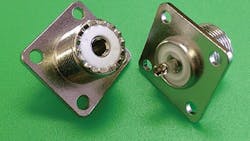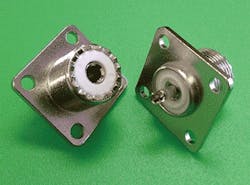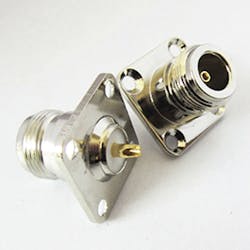What's the Difference Between Coaxial Connectors (Part 1)?
Download this article in .PDF format
This file type includes high-resolution graphics and schematics when applicable.
Although often taken for granted, coaxial connectors are a key aspect of any RF/microwave application. While they may receive less attention than other components, connectors nonetheless must provide adequate performance to avoid any system degradations. Therefore, anyone tasked with selecting coaxial connectors for any given application should clearly understand the parameters that define connector performance.
This article, Part 1, provides a general overview of coaxial connectors. The important parameters that define performance are discussed, as is some of the terminology commonly used to classify connectors. This article also begins to discuss some of the various types of coaxial connectors. Part 2 will describe other regularly used coaxial connectors.
It should be noted that this series makes no claim to be an exhaustive list; the two articles do not cover every type that’s on the market. With that being said, some of the more prevalent coaxial connectors employed throughout the RF/microwave industry will be found here.
Introduction to Connectors
Today’s designers can select from a large array of connectors available from various suppliers. This wide assortment is in direct contrast to the early days of connectors—back in 1940, the UHF connector was the only choice.
However, as demands of high-frequency applications increased throughout the years, the variety of connectors also grew in scope. Specifically, new connectors were developed to handle progressively higher-frequency operation. Today, connectors can be used at frequencies as high as 100 GHz and beyond.
Choosing a proper coaxial connector requires an understanding of its characteristics—both electrical and mechanical. Obviously, a connector’s physical size is an important aspect. Furthermore, multiple performance characteristics, such as frequency range and power-handling capability, must be examined when making a selection. Other important parameters include insertion loss and voltage standing wave ratio (VSWR) . And environmental characteristics, such as operating temperature, vibration, and shock, help determine if a connector is suitable for a given application. Of course, cost plays a key role, too.
Generally, coaxial connectors consist of an outer conductor contact and an inner conductor contact. These devices also must have the means to mechanically couple to another connector. Some connectors are named after the inside diameter of their outer conductor, with smaller diameters yielding higher usable frequencies.
Connectors are designed with either an air or a solid dielectric. Air-dielectric types include 3.5-, 2.92-, and 2.4-mm connectors, among others. A good example of a connector that employs a solid dielectric is the widely used SMA connector. A solid dielectric can be implemented with either a flush or overlapping configuration; overlapping configurations are employed to prevent voltage breakdown and to handle higher power levels.
Connectors can be mounted by various means. Those intended to mount onto printed-circuit boards (PCBs) are manufactured with either a straight or right-angle orientation. Cable-mount connectors can be attached to cables by means of either crimping or clamping. And panel-mount connectors include those with flanges, which typically have either two or four holes.
Materials
Manufacture of coaxial connectors involves various materials, each having their own set of advantages and disadvantages. Such materials are evaluated by their electrical, mechanical, and environmental properties, and they weigh heavily in terms of connector performance and reliability.
Two of the more commonly used materials for building connector bodies are stainless steel and brass. Stainless steel is more durable than brass, but it comes at a higher cost. The highest-quality connectors are often manufactured with stainless-steel bodies. Connector contacts, on the other hand, are typically not made of stainless steel, which has a relatively low electrical conductivity. Rather they often consist of brass or beryllium copper.
To improve the quality of a connector, manufacturers will generally plate the bodies and contacts with a metal finish. For instance, connector contacts made of copper or brass are commonly gold-plated, as gold is an excellent conductor and highly resistant to corrosion. Silver is used in some instances as well.
Due to the high cost of gold, gold-plating for connectors usually comprises a very thin layer, enabling manufacturers to still reap its benefits while only using a minimal amount. However, the thin gold layer can lead to the diffusion of the base material onto the gold surface. Thus, a suitable metal—often nickel—is typically underplated beneath the gold layer. It acts as a barrier to prevent diffusion.
In addition, manufacturers utilize different forms of finishing for connector bodies, such as gold, silver, and nickel. Another alternative employed by manufacturers is white bronze. Some connectors are available with passivated body finishes as well.
Connector Terminology
The vast majority of standard connector types have both a male and female variant, which join together to form a mated pair. Male connectors are known as plugs, and female connectors are referred to as jacks. Furthermore, the male contact is a pin, while the female contact is a socket. Genderless connectors, such as the APC-7 connector (also known as the 7-mm connector), also exist.
Connector pairs are mated by several coupling techniques, such as threaded, bayonet, and snap-on coupling. Threaded-coupling connectors include SMA and Type-N. The BNC connector implements the bayonet-coupling technique, while the SMB connector takes advantage of the snap-on-coupling technique.
Early Days of Connectors
As mentioned, prior to World War II, the UHF connector was the only coaxial connector used for RF applications (Fig. 1). E. C. Quackenbush of the American Phenolic Corporation (later Amphenol) developed the connector in the 1930s. It functioned reliably at frequencies as high as 300 MHz, which was considered high frequency at the time. Still manufactured today, the UHF connector, which employs threaded coupling, derives its name from the acronym for Ultra High Frequency (UHF).
Although the UHF connector was reliable for applications to 300 MHz, higher-frequency requirements soon emerged. That mandated new connector designs, since the UHF connector was not suitable at such frequency levels. Thus, a joint U.S. Army-Navy RF Cable Coordinating Committee (ANRFCCC) was established in the early 1940s to develop standards for RF cables, rigid transmission lines, and connectors for radio and radar equipment. In 1942, the ANRFCCC introduced the Type-N connector (Fig. 2).
In Part 2 of this series, we’ll further explore the popular Type-N connector, and describe other commonly used coaxial connectors such as the SMA and 2.4-, 2.92-, and 3.5-mm varieties. It will also cover the characteristics of each of these, as well as other coaxial connectors.
Looking for parts? Go to SourceESB.



